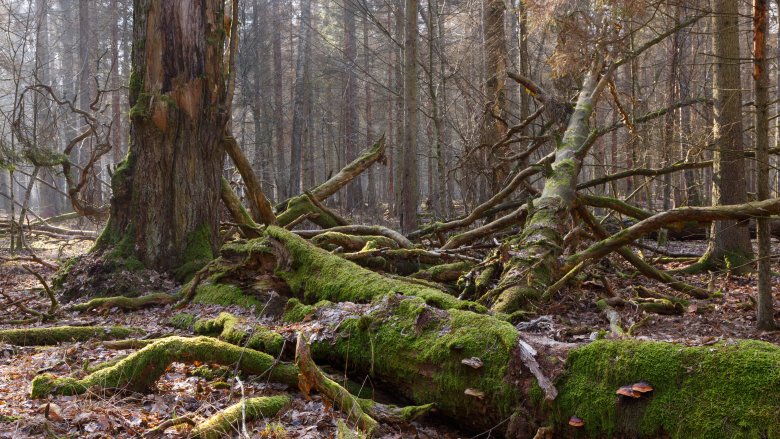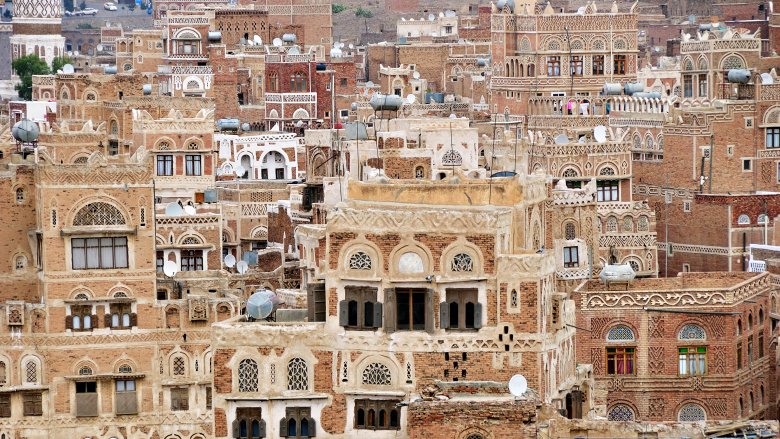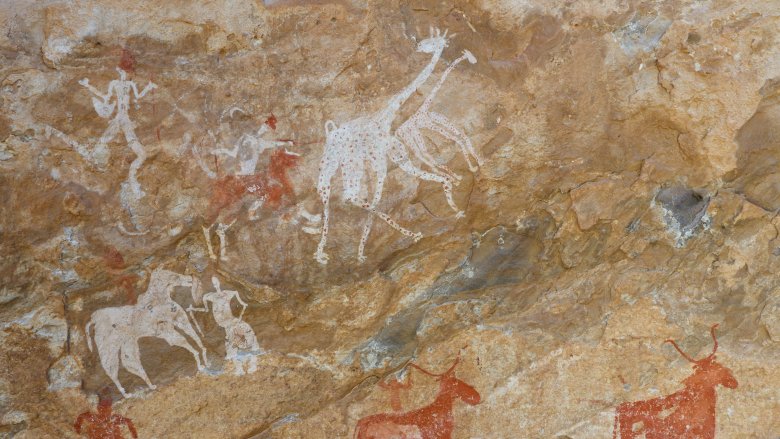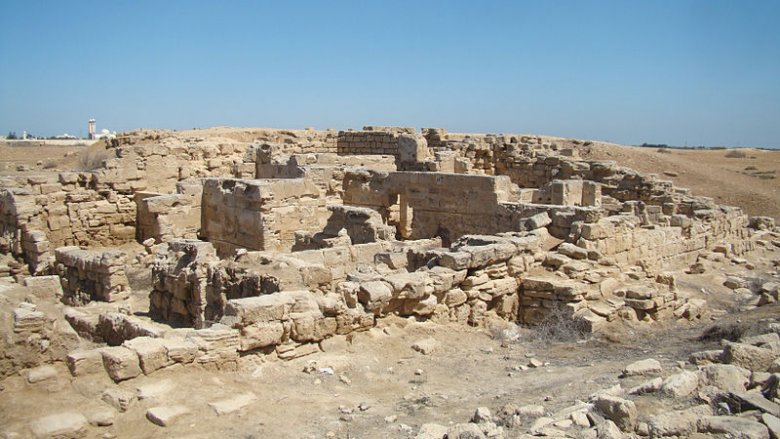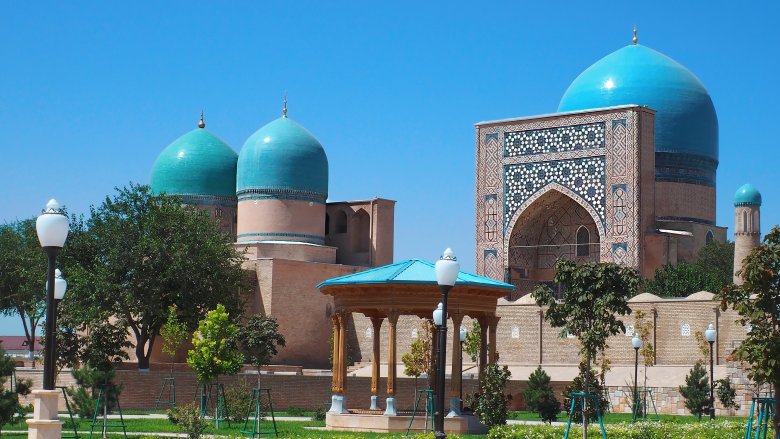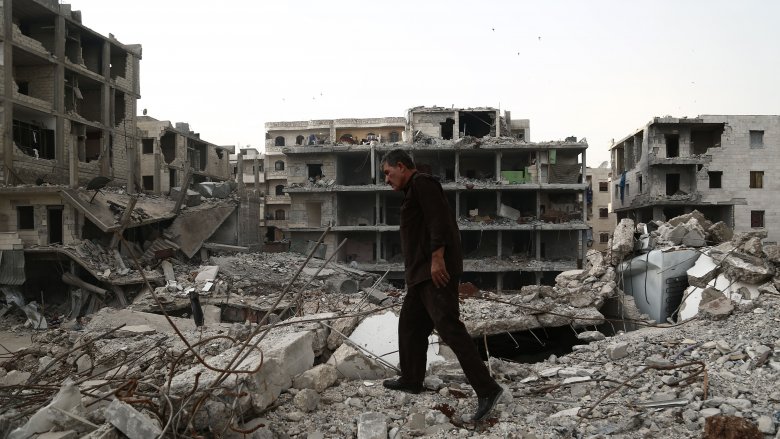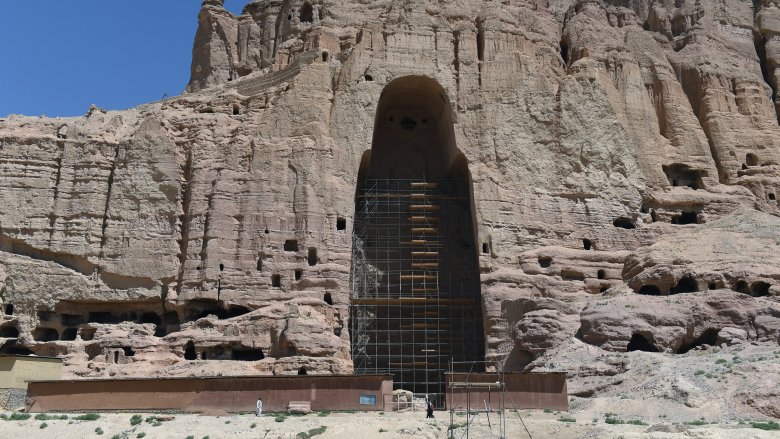World Heritage Sites That Might Not Exist In 10 Years
It's easy to forget it when you're living in a world ravaged by hatred and unrest, but our planet is a pretty amazing place. There are sights so divine it's tempting to think God just stuck them there to show off. And that's not even mentioning the crazy awesome stuff we humans have managed to knock up over the centuries. Cathedrals, pyramids, Great Walls ... the world is full of treasures, manmade or otherwise. We even have an official Top 1,000 list (or top 1,092, to be pedantic): UNESCO's collection of World Heritage sites.
But just because something is a World Heritage site doesn't mean it's gonna be around forever. Every minute of every hour of every day, a toxic combination of climate change, human stupidity, and sheer bad luck is conspiring to snatch our planet's treasures away from us. Some sites, like Venice, doomed by rising sea levels, will disappear within a century. Others could well vanish before a decade is out. If you have a hankering to see any of these places, you should probably think about crossing them off your bucket list sharpish.
Tanzania's Selous Game Reserve will soon be underwater
Tanzania is seriously big. How big? So big the government has been able to put aside a swathe of land the size of Switzerland as a wildlife reserve. Known as the Selous Game Reserve, this African Switzerland is just like regular Switzerland only instead of Alpine peaks it has low wetlands, and instead of chocolate, it has elephants, giraffes, rhinos, and 12 percent of the continent's wild dogs. (Okay, so it's actually not like Switzerland at all.)
But the Selous Game Reserve is still impressive enough that UNESCO added it to their list in 1982, citing the fact that it's one of Africa's last wilderness areas to be undisturbed by humans. Flash-forward to the present, though, and this slice of untouched land may be about to get not just touched by humans, but kicked, spat on, rolled up in a carpet, and hurled off a bridge. According to Deutsche Welle, the Tanzanian government has approved plans to build a hydroelectric dam and flood huge tracts of the reserve.
Remarkably, this isn't the only way the guys in Dodoma are planning to trash their own heritage. There are simultaneous plans to start logging in Selous, to begin oil and gas extraction, and to open a uranium mine. The Tanzanian government says the projects and the electric created by the dam will shore up the economy. Their detractors say flooding a major tourist destination in a country that relies on tourism will do the exact opposite.
Poland's ancient Bialowieza Forest is becoming a giant lumber mill
Not so very long ago, Europe was covered in great, impenetrable forests where wolves and bears and wicked witches lurked. Then came the industrial revolution, and suddenly all that primeval forest was reduced to just a few tiny specks logging companies hadn't quite got around to felling. One of those tiny specks is Poland's UNESCO listed Bialowieza Forest, a tiny slice of history on the Polish-Belarusian border that's home to a quarter of the world's European bison. At least, for now it is. Starting in 2016, Poland's government began allowing logging in the protected area, leading to what we're gonna dub the "Tree-pocalypse."
The Guardian has the details. After many decades of protection, the government opened the forest to logging, ostensibly to protect the forest from a bark beetle infestation, but probably mainly to line the pockets of people connected to the government. The then-environment minister Jan Szyszko, who apparently assumed his job title came with sarcastic air quotes around it, tripled logging limits just after the chopping started, despite everyone telling him this was a terrible idea.
In the end, the EU stepped in and threatened to fine Poland heavily unless logging stopped, and it duly did after 100,000 ancient trees had been lost. But this was only a reprieve. In 2019, it was reported by environmental groups that Warsaw was planning to restart logging again.
Yemen's ancient capital is already turning into Yemen's great big pile of dust
Way back in the 11th century, a bunch of guys living in the ancient Arabian city of Sana'a started building towering homes of reddish mud baked into bricks. The buildings that sprang up were utterly hypnotic. Tall, thin, and decorated with white trimming, they looked like gingerbread houses comes to life. As the world rumbled on, 6,000 of these old houses somehow survived all packed in together, eventually becoming Yemen's premier World Heritage site. And then 2015 came and everything went to hell.
That March, Yemen's fractured post-Arab Spring society became Yemen's kamikaze civil war. As the nation spiraled out of control, neighbor Saudi Arabia decided to get involved, leading to years of indiscriminate airstrikes on Yemen. Thousands upon thousands of people have since died. But there's been another casualty of the fighting. Back in 2018, Reuters reported that the beautiful old homes of Sana'a had been reduced to so much dust and rubble.
Because the civil war has made Yemen a very dangerous place, no one's been able to actually go into Sana'a and say "Holy heck, this precise percentage of the Old City is gone, you guys." Still, we know a great deal of Yemeni and Islamic history has vanished in the flash of Saudi bombs. It may be that Sana'a will one day be rebuilt. Or it may just keep getting pulverized until there's nothing left but dust.
Libya's ancient rock art sites are pretty much gone
Did you know the Sahara wasn't always a great big desert? It seems kind of obvious when you think about it, but it can take a concrete example to make you lose the image of sand in your head. The ancient rock art sites of Tadrart Acacus in Libya's remote south are such an example. A series of cave paintings dating all the way back to 12,000 B.C., they show how the world of the Sahara changed over millennia. You can see animals appear and disappear, vegetation spring up only to vanish from later paintings. Looking at the drawings is like looking at a living timeline of human prehistory, stretching from before the dawn of agriculture all the way up to 100 A.D.
Sounds impressive, huh? Well, hold onto that feeling of wonder because it's the closest you'll ever get to the real thing. In 2018, UNESCO released a gloomy report on the site after years of civil war in Libya. They concluded 95 percent of the paintings had been damaged or stolen.
The problem predates Libya's current war, with locals in 2009 starting a tradition of spray painting over the ancient art. But the implosion of Gaddafi's regime made everything a bazillion times worse. There is nobody left to protect the rock art, and so the whole lot is now being either looted or just smashed up by bored militias. Forget ten years, this piece of our heritage could be gone in ten months.
Abu Mena in Egypt could collapse at any moment
Many moons ago, Abu Mena in Egypt was a bustling Byzantine Christian metropolis that doubled as a pilgrimage center. You wouldn't think so looking at it now. Ruined for centuries, Abu Mena now looks less like a city and more like a whole lot of broken pillars crisscrossed with yet more broken ruins. But while Abu Mena may not appear all that fascinating to the untrained eye, it's a visual treat for any historian of Coptic Christianity. UNESCO considers the site so important that they listed it alongside the much more famous Thebes in 1979.
Unfortunately, Abu Mena has a problem that none of Egypt's other ancient icons suffer from. As the Telegraph explains, the city was built atop dry, hard-packed clay. This was fine when everything stayed dry, but became a kind of gigantic problem when the cracking of multiple cisterns on the site combined with local flooding to turn the ground liquid. Since 2001, Abu Mena has effectively been living out Jesus' parable about the foolish guy who built his house on sand. Only when Abu Mena finally goes crashing over, it's gonna take our ancient history with it.
There have been attempts to keep Abu Mena standing, but they've been kind of destructive in their own way. Local authorities were forced to pack underground crypts with sand to keep the surface structures standing, reburying our heritage in the process. Things are so bad that parts of the site could fall down at any moment.
Half the Barrier Reef is dead, and it's not coming back
Pop quiz: What's the only living thing so big that it can be seen from space? Nope, the answer is not "yo momma." According to the European Space Agency, the Great Barrier Reef off Australia's north coast holds the record. At over 2,000 km long, the reef is big almost beyond comprehension. Its biodiversity is up there with the Amazon. Over 2 billion corals lived on the World Heritage-listed reef in 2015, alongside a kaleidoscopic array of fish, seaweed, molluscs, and other forms of life.
You may have noticed the key words in that last sentence: "in 2015." Why such an arbitrary point? It's not because that's when we last have data for, it's because any later and the numbers no longer hold true. In 2016 and 2017, a surge of warm water triggered by climate change settled over the reef, effectively starving the corals to death. Half the reef died in what's been called "an unprecedented bleaching event" (via the Atlantic). What's worse, it ain't coming back.
Coral bleaching isn't normally permanent death. The Barrier Reef has suffered smaller-scale bleaching before and survived. But it does require huge scales of time, like 100 years or so, for it to regrow. With the oceans continuing to warm, that's probably not gonna happen. Even if the Barrier Reef starts to recover, all it would take is another event like 2016 to kill it all off all over again. And guess what? Those events are becoming more frequent.
Shahrisabz on the Silk Road is turning into a tacky theme park
Back in the 15th and 16th centuries, Shahrisabz (also spelled Shakhrisyabz) in modern-day Uzbekistan was the place to be. A major stopping post on the ancient Silk Road, it grew into a vast world of towering palaces, blue-domed tombs the size of mansions, and so many statues it's a wonder the streets had room for real, non-marble people. As UNESCO notes, many of these structures survived right into modern times, giving Uzbekistan a second major tourist destination outside Samarkand. Not that tourists today go to Shahrisabz for the gorgeous Silk Road structures, oh no. They go to see the tacky theme park the Uzbek government built over the bulldozed old town.
Radio Free Europe/Radio Liberty has the scoop. In 2017, some bright spark in the Uzbek government decided the winding old town and hidden passageways of Shahrisabz were getting in the way of all the tourists who wanted a hassle-free visit. So they demolished a 2 km stretch of protected buildings and replaced them with a boulevard, parking lot, and what UNESCO called a "modern theme park," because why have history when you can have a tacky recreation of it with cotton candy?
Sadly, no one seems to have learned their lesson. UNESCO still lists Shahrisabz as "at risk," suggesting yet more centuries-old buildings may get knocked down soon. At least it'll be worth it when they finally build the roller coaster.
Vienna's historic center won't be destroyed but could be delisted
Vienna, capital of Austria, is a prosperous city in a wealthy country, surrounded by the sea of stability that is Europe's center. It's been named the world's most livable city by the Economist's Intelligence Unit. It's exactly not the sort of place where you'd find the government building a hydroelectric dam or tacky theme park over its World Heritage-listed historic core. So what's it doing here? Well, it turns out there are two ways World Heritage sites can cease to exist. One is the classic "destroy everything" way. The other is for UNESCO to delist them. That's exactly what the organization is threatening to do with Vienna's historic core.
Back in 2017, the Telegraph reported that Vienna's City Council had given permission for a gigantic complex of luxury hotels, ice rinks, and vast towers to be built in Vienna's center. While the 6.5 km-square site would lie outside the protected core, it would be just outside. When UNESCO heard the news, they declared such a monstrosity would compromise the historic character of the city center. The last update, in 2018, said the project was still on schedule for a 2020 or 2021 start and could result in Vienna being stripped of its World Heritage status.
This isn't just an idle threat. In 2009, the building of a vast eyesore of a bridge across Dresden's Elbe Valley led to UNESCO delisting the property (via BBC). Don't mess with the UN.
Haida Gwaii's totem poles are about to vanish (and that's okay)
Just off the coast of British Columbia lies one of Canada's most pristine wildernesses. Haida Gwaii is home to so much beauty that each glimpse is like downloading a thousand nature documentaries direct into your eyeballs. But even this pales beside the remains of sGang Gwaay. A 1.8-mile-long island in Haida Gwaii, sGang Gwaay is home to the untouched remains of a 19th-century Haida native village. Carved wooden totem poles dot the landscape, each telling a unique story that has never been told before and will never be repeated. This is bad news if you're planning to visit in a decade or so because those poles aren't expected to survive ten years. Now for the twist: It turns out everyone is totally cool with this.
As Atlas Obscura explains, the intricate totem poles are rotting away, casualties of Canada's punishing winter weather. However, no one is trying to save them, and UNESCO is making no noise about their imminent passing, for the very good reason that they were built to die in the first place.
The Haida people believe everything has a natural life span. That includes humans and animals and, yes, also totem poles. Long ago, it was decided their totems should be allowed to naturally fall apart, which explains the decayed state of the 26 on sGang Gwaay. Any efforts to preserve these poles would go against everything their creators believe, so instead we're allowing them to slowly fade away. What a romantic way of looking at things.
A whole lot of Syria's wrecked sites won't get rebuilt
For a couple of years in the mid-2010s, the religious Third Reich tribute act known as ISIS made a perverse hobby of blowing up World Heritage. Across Syria and Iraq, priceless monuments were exploded just so a few jihadist bros could get their rocks off. That's not even counting the Assad regime's aerial bombardments of ancient buildings outside ISIS territory. Every single one of Syria's six World Heritage sites is listed as being in danger.
To be fair, we've destroyed priceless places before and just rebuilt them. The Ottoman bridge in Mostar was blown up during the Bosnian War, rebuilt in the 2000s, and is now a World Heritage site again. So you might be forgiven for wondering what the difference is. Sadly, it's a big one.
Rebuilding one bridge is a lot different from rebuilding a functioning city. UNESCO's own report on Aleppo's devastated core (above) notes that locals can't wait around for UNESCO to rebuild their city, so they're throwing up whatever concrete shelters they can. On the one hand, this will mean a rebuilt Aleppo where no one dies of exposure. On the other, it will mean an Aleppo that probably looks like Des Moines. Then there are issues of funding. The Financial Times notes that sanctions mean Western governments won't be able to foot the bill for rebuilding Syria's heritage, while Assad-allied nations like Russia and Iran are too broke or simply don't care enough. The war may be over, but old Syria is gone.
We can't save the Bamiyan Buddhas without killing them
You may be surprised to see the Bamiyan Buddhas on this list, given they were dynamited by the Taliban back in 2001 (via Telegraph). But if you visit UNESCO's website and go looking, you'll find the Bamiyan valley and its wrecked Buddhas are still listed as World Heritage sites. This is because it's UNESCO policy to not just write something off if it's been destroyed by war or violence, but to see first if there's any chance of rebuilding.
However, there is a catch. Currently, the empty niches the Buddhas were carved into can remain World Heritage sites. But if anyone does attempt to rebuild them, UNESCO rules state they can only do so using original materials. This is a problem, as only a third of the original material was saved after the statues went kapow (via the Guardian). The wreckage of the Buddhas may automatically keep the UNESCO designation, but if they're ever rebuilt, they will be automatically struck off.
This kinda sucks from the perspective of the locals. The region (which is Shia Muslim) never supported the Sunni Taliban's extreme version of Islam, and would kind of like to have their idolatrous statues back. There was hope that rebuilding them might encourage tourism, but if rebuilding them gets them delisted by UNESCO, all that might fall through. So it's a choice of having two holes in a wall that are recognized by the agency, or two new statues that are instantly struck off. Sigh.


